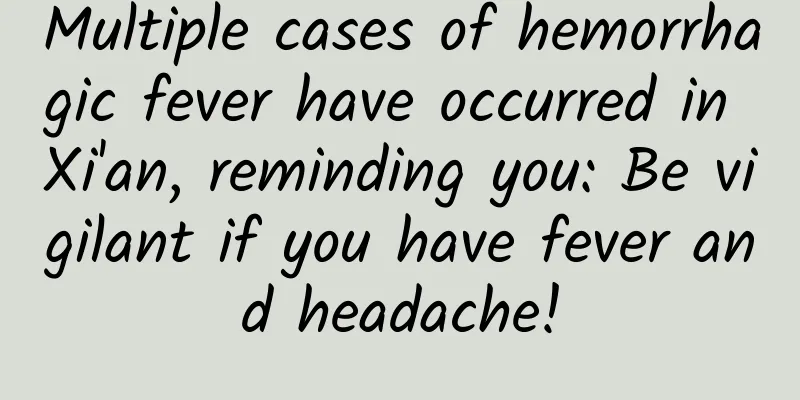Multiple cases of hemorrhagic fever have occurred in Xi'an, reminding you: Be vigilant if you have fever and headache!

|
Since the beginning of winter this year, major hospitals in Xi'an have successively received many patients with hemorrhagic fever. Starting from October every year, the Guanzhong area of Shaanxi Province enters the high-incidence season of hemorrhagic fever. Since the early symptoms of epidemic hemorrhagic fever are similar to those of common influenza, many patients mistakenly think it is a common cold. What kind of disease is hemorrhagic fever? Can it be transmitted from person to person? How to prevent hemorrhagic fever? Follow NetEase Health's "Health Focus" to learn more! 1. What is epidemic hemorrhagic fever? What are its symptoms and manifestations? Epidemic hemorrhagic fever, also known as hemorrhagic fever with renal syndrome, is an important infectious disease that endangers human health. It is caused by the epidemic hemorrhagic fever virus (hantavirus) and is a natural epidemic disease with rodents as the main source of infection. Fever, headache, back pain, orbital pain, nausea, vomiting, chest tightness, etc. are common symptoms of hemorrhagic fever; fever, bleeding, congestion, hypotension shock and kidney damage are the main clinical manifestations.
2. Is hemorrhagic fever an infectious disease? How is it transmitted? Who is most likely to get it? Epidemic hemorrhagic fever is an infectious disease. The main hosts and sources of infection of Hantavirus are small rodents, including wild mice and domestic mice; Epidemic hemorrhagic fever is mainly transmitted by animals, and the virus can be excreted through the blood, saliva, urine, and feces of host animals; direct transmission from rats to humans is an important route of infection for humans, and there are four confirmed routes: 1. Infection through respiratory inhalation of virus-contaminated aerosols, 2. Infection through the digestive tract by eating food contaminated by rodent excrement carrying the virus, 3. Infection through rat bites or wounds coming into contact with virus-carrying rat excrement or blood, and 4. Pregnant women infected with the disease can infect their babies through the placenta.
It is generally believed that the general population is susceptible, but only some people develop the disease after infection, and most people are latently infected. Generally, the incidence rate is high among young and middle-aged male farmers and workers. Although children are also susceptible, the incidence rate is relatively low; the incidence rate of different populations is related to the chance of contact with the source of infection. Patients with hemorrhagic fever can obtain lasting immunity after the disease, and rarely suffer from a second infection. 3. Is hemorrhagic fever easy to treat? Will there be any sequelae after being cured? The mortality rate is as high as 20% to 90%. Hemorrhagic fever is divided into five stages: fever stage, hypotension shock stage, oliguria stage, polyuria stage, and recovery stage. The total course of the disease is generally recovered in 2-3 weeks. The specific course of the disease is related to the type of infected virus, the severity of the disease, the early or late treatment, and whether the measures are appropriate. Patients should be hospitalized for isolation treatment and close observation in time, follow the doctor's advice and pay attention to the correct treatment of each stage, supplement with sufficient fluids and electrolytes, and fluid replacement should be mainly isotonic and saline. Commonly used are balanced salt solutions and glucose saline to maintain water, electrolyte and acid-base balance. Patients with high viral load in the body and severe damage to major organs such as liver and kidneys have a poor prognosis. 【Vaccine-related issues】 1. How many times do I need to receive the hemorrhagic fever vaccine? When should I receive it? How is it administered? my country currently uses three types of bivalent inactivated vaccines for hemorrhagic fever with renal syndrome, which are obtained from three different cell cultures, namely Vero cells, primary hamster kidney cells and primary gerbil kidney cells. The bivalent vaccine is given as a basic immunization with two injections, one on day 0 (the same day) and one on day 14 (the fifteenth day), and a booster injection is given one year after the basic immunization. The bivalent vaccine is injected intramuscularly into the deltoid muscle of the upper arm, with each dose being 1.0 ml. 2. What are the types of hemorrhagic fever vaccines? Which hemorrhagic fever vaccine is used in my country's immunization program? There are currently three types of bivalent inactivated vaccines for hemorrhagic fever with renal syndrome in my country, namely, bivalent inactivated vaccine for hemorrhagic fever with renal syndrome (Vero cells), bivalent inactivated vaccine for hemorrhagic fever with renal syndrome (hamster kidney cells), and bivalent inactivated vaccine for hemorrhagic fever with renal syndrome (gerbil kidney cells). All three vaccines are used in my country's immunization program. 3. Which groups of people are suitable for the hemorrhagic fever vaccine? Residents of and people entering areas affected by hemorrhagic fever with renal syndrome, mainly high-risk groups aged 16 to 60 years old. 4. What are the contraindications for hemorrhagic fever vaccination? People with the following symptoms or conditions are not suitable for vaccination: ① Those who are known to be allergic to any ingredients contained in the vaccine, including excipients, formaldehyde and antibiotics; ② Those suffering from acute diseases, severe chronic diseases, acute exacerbation of chronic diseases and fever; ③ Those suffering from uncontrolled epilepsy and other progressive neurological diseases; ④Pregnant and lactating women. 5. What are the possible adverse reactions after receiving the hemorrhagic fever vaccine? There are generally no adverse reactions after injection. Some individuals may experience pain, itching, redness and swelling. Systemic reactions may include fever, discomfort, fatigue, etc., which generally do not require treatment and can be relieved on their own. A few people have rashes, and anti-allergic drugs are given when necessary. Because the vaccine contains adsorbents, a small number of vaccinated subjects may have local nodules, mild swelling and pain, which will subside within 1 to 3 days. In recent years, there have been reports of allergic rashes, anaphylactic shock, allergic purpura, peripheral neuritis, etc., but they are extremely rare. 6. If I don’t live in the countryside and there are no mice in my home, I won’t be infected with hemorrhagic fever and there is no need to get vaccinated? Not living in the countryside and having no rats at home only means that the chance of contact with rats is lower, and you are at low risk of hemorrhagic fever. However, there is also the possibility of being bitten by rats when going out, and the possibility of infection cannot be ruled out. It is recommended to check local information before traveling. If it is an area with a high prevalence of hemorrhagic fever, it is best to get vaccinated in advance.
7. Does the hemorrhagic fever vaccine provide lifelong immunity after vaccination? Do I need to get a booster shot after a few years? It is recommended to give a booster shot one year after completing the basic vaccination, which will have a more lasting effect. Large-scale observations on the persistence of immunity organized by my country show that the protection rate is still above 92% six years after the basic vaccination. However, there are individual differences, and it cannot be guaranteed that everyone will obtain lasting immunity or even lifelong immunity after vaccination. Generally, repeated injections are not required, but if the antibodies are attenuated and the person is in an epidemic area, booster shots are recommended.
8. What should you do after being bitten by a rat? ① Treat the wound: After being bitten by a rat, disinfection should be done as soon as possible. First, wash the wound with clean water and soapy water, try to squeeze out the blood from the rat bite, and then use medical alcohol to disinfect. If the wound is relatively small, you can directly wipe it with a cotton swab dipped in alcohol. If the wound is more serious, it is recommended to pour alcohol directly on the wound. Do not bandage the treated wound, open it to ventilate, and go to the hospital for treatment as soon as possible.
② Go to the hospital for vaccination: For general bites, you can be injected with anti-rabies vaccine and inactivated vaccine for hemorrhagic fever with renal syndrome. If the wound is deep and serious, you can be injected with rabies immunoglobulin. 9. Where can I get the hemorrhagic fever vaccine? (Already consulted the National Health 12320) NetEase Health has contacted the public health charity hotline 12320 by phone. The reply will depend on whether the local CDC has hemorrhagic fever vaccine. If not, there is no need to worry. The local CDC will report the demand and mobilize the vaccine. |
Recommend
The software we uninstalled together in those years...
Recently, my IQ was exposed by a screenshot of a ...
Are carbon plate shoes reliable for speed increase? In short, teenagers should wear less
In the pursuit of sports performance, carbon plat...
Is it funding or technical issues that make it so difficult to return to the moon 50 years after the Apollo program?
For a long time, doubts about the Apollo manned m...
From the hit of "Ode to Joy" to how video websites grasp the lifeline of drama selection
The TV series "Ode to Joy" starring Liu...
What does Jack Ma’s “ecosystem” really mean?
Alibaba's listing has become the hottest head...
10 Mistakes Every Programmer Makes
[[131972]] The 10 mistakes listed in this article...
Guess what? It’s not mind reading, but predictive processing of the brain
Produced by: Science Popularization China Author:...
How to build a reasonable B-side operation system?
This article is a review and summary of the autho...
The great American developer teaches you three tricks to get into the App Store recommended catalog!
Introduction: Robleh Jama is an experienced appli...
The color TV industry is still the same and there is no story to tell
The color TV market in the first half of 2016 (th...
Why hasn't Google produced a product that revolutionized the world since search?
Google has been a paradise for engineers since it...
Analysis of WeChat reading products!
This article is the first in a series of analysis...
[Smart Farmers] Is the “fresh and clean” Aster a “nutrient plunderer” with great destructive power?
When it comes to invasive alien plants, the most ...
Finally! It has been made clear: it is forbidden to make and publish videos of overeating, which is very harmful
It is shameful to waste food, and overeating is h...
Hydrogen drives the future, South Korea is fully betting on hydrogen fuel technology
Hydrogen fuel cell vehicles use hydrogen as fuel ...









